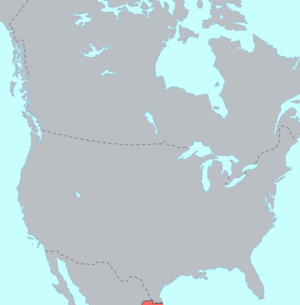Comecrudan languages
Comecrudan refers to a group of possibly related languages spoken in the southernmost part of Texas and in northern Mexico along the Rio Grande of which Comecrudo is the best known. Very little is known about these languages or the people who spoke them. Knowledge of them primarily consists of word lists collected by European missionaries and explorers. All Comecrudan languages are extinct.
| Comecrudan | |
|---|---|
| Geographic distribution | Rio Grande Valley |
| Linguistic classification | Hokan ?
|
| Glottolog | None |
 Pre-contact distribution of Comecrudan languages. (Distribution continues to the south.) | |
Family division
The three languages were:
Genetic relationships
In John Wesley Powell's 1891 classification of North American languages, Comecrudo was grouped together with the Cotoname and Coahuilteco languages into a family called Coahuiltecan.
John R. Swanton (1915) grouped together the Comecrudo, Cotoname, Coahuilteco, Karankawa, Tonkawa, Atakapa, and Maratino languages into a Coahuiltecan grouping.
Edward Sapir (1920) accepted Swanton's proposal and grouped this hypothetical Coahuiltecan into his Hokan stock.
After these proposals, documentation of the Garza and Mamulique languages was brought to light, and Goddard (1979) believes that there is sufficient similarity between them and Comecrudan for them to be considered genetically related. He rejects all other relationships.
Powell's original Coahuiltecan, renamed Pakawan and extended with Garza and Mamulique, has been defended by Manaster Ramer (1996), who also sees a relationship with Karankawa probable and Atakapa as a more distant possibility.
Evidence
The following table of common core vocabulary constitutes the complete evidence given by Goddard (1979) in support of a Comecrudan family:
| Comecrudo | Garza | Mamulique | meaning |
|---|---|---|---|
| al | ai | atl | 'sun' |
| eskan | an | kan | 'moon' |
| apel | apiero | – | 'sky' |
| na | knarxe | kessem | 'man' |
| kem | kem | kem | 'woman' |
| apanekla | axe | aha(?) | 'water' |
| aaul | aie | – | 'road' |
See also
- Native American languages
- Classification schemes for Native American languages
- Atanaguaypacam Indians from the Handbook of Texas Online
- Coahuiltecan
Bibliography
| Wiktionary has a word list at Appendix:Comecrudo word list |
Archives
Secondary literature
- Campbell, Lyle. (1997). American Indian languages: The historical linguistics of Native America. New York: Oxford University Press. ISBN 0-19-509427-1.
- Campbell, Lyle; & Mithun, Marianne (Eds.). (1979). The languages of native America: Historical and comparative assessment. Austin: University of Texas Press.
- Goddard, Ives. (1979). The languages of south Texas and the lower Rio Grande. In L. Campbell & M. Mithun (Eds.) The languages of native America (pp. 355–389). Austin: University of Texas Press.
- Goddard, Ives (Ed.). (1996). Languages. Handbook of North American Indians (W. C. Sturtevant, General Ed.) (Vol. 17). Washington, D. C.: Smithsonian Institution. ISBN 0-16-048774-9.
- Goddard, Ives. (1999). Native languages and language families of North America (rev. and enlarged ed. with additions and corrections). [Map]. Lincoln, NE: University of Nebraska Press (Smithsonian Institution). (Updated version of the map in Goddard 1996). ISBN 0-8032-9271-6.
- Manaster Ramen, Alexis. (1996). Sapir's Classifications: Coahuiltecan. Anthropological Linguistics 38/1, 1–38.
- Mithun, Marianne. (1999). The languages of Native North America. Cambridge: Cambridge University Press. ISBN 0-521-23228-7 (hbk); ISBN 0-521-29875-X.
- Saldivar, Gabriel. (1943). Los Indios de Tamaulipas. Mexico City: Pan American Institute of Geography and History.
- Sapir, Edward. (1920). The Hokan and Coahuiltecan languages. International Journal of American Linguistics, 1 (4), 280-290.
- Sturtevant, William C. (Ed.). (1978–present). Handbook of North American Indians (Vol. 1-20). Washington, D. C.: Smithsonian Institution. (Vols. 1–3, 16, 18–20 not yet published).
- Swanton, John R. (1915). Linguistic position of the tribes of southern Texas and northeastern Mexico. American Anthropologist, 17, 17–40.